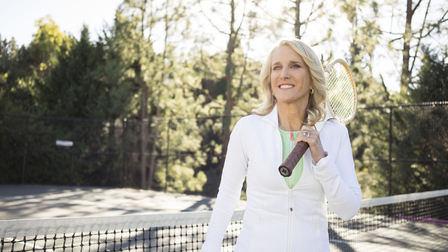Advantage Austin
Winning smile: Tracy Austin won cars before she even had a driver’s license. At just fifteen years of age she wowed spectators in Filderstadt.
Tracy Austin is no stranger to the fast lane. A child prodigy, she won her first
There are moments when even Tracy Austin gets carried away—by sheer enjoyment. Driving on winding roads through the hills of Palos Verdes, south of Los Angeles, she steps on the gas. Her
Austin climbed high at quite a young age, and the view of the world must have been breathtaking. At fourteen, she was the youngest player to ever qualify for the US Open in New York. In 1978, at the age of fifteen, she won both the singles and doubles titles at the inaugural
![[+]](https://files.porsche.com/filestore/image/multimedia/none/christophorus-issue380-article10-content-01/normal/872dcc05-e7ae-11e6-8503-0019999cd470/porsche-normal.jpg)
Born into a childhood of tennis
Austin is now fifty-four and drives a 911 GT3 RS. The
Austin was the youngest of five children in what was essentially a tennis family. Her mother worked at a tennis club not far from Austin’s home today. All of the children played the game, and Tracy started swinging a racket as soon as she outgrew her tricycle. “I would spend hours hitting balls against a wall and was thrilled when I managed to hit ten in a row,” she recalls. At some point the club manager noticed how much she enjoyed what she was doing. He promised her little trophies for ever greater numbers of hits—and ignited her ambition.
Austin’s innate ambition distinguishes her from many tennis stars who were, or are, spurred on by ambitious parents. Her father, a scientist, was not overly impressed by her success at the game. “When I asked him once to attend a match against Steffi Graf, he declined on account of a computer seminar.” Austin was not upset by this—on the contrary. The fact that her parents’ love and respect for her was not based on wins took the pressure off and helped her keep a level head.
![[+]](https://files.porsche.com/filestore/image/multimedia/none/christophorus-issue380-article10-content-02/normal/2ac2c5a6-e7a0-11e6-8503-0019999cd470/porsche-normal.jpg)
A nearly forty-year connection with
Grand Slam champion back at school
Not happy: Martina Navrátilová (left) is visibly disappointed by her loss to the young Tracy Austin.
Keeping her feet on the ground and her nose to the grindstone—this challenge was the same for Tracy the schoolgirl and Austin the tennis pro. “I was the first player to have that much success so young. There weren’t any role models. So I had to try to make all the right decisions on my own.” For example, she decided to stay in high school despite her spectacular career in tennis. Two days after winning the US Open in New York, she was back in class as if nothing had happened. She didn’t enter other Grand Slam tournaments because they conflicted with her tests. Emulating her parents' capacity for hard work, she was dedicated to meeting expectations on and off the court. Her mother accompanied her to every tournament around the world. She was a mild-mannered coach, says Austin: “I don’t think she ever criticized my play during a game.” Her mother was also there for the first
That special atmosphere may also have been one of the reasons why the tournament, which was moved to Stuttgart’s
Fighting spirit required
Since leaving active play, Austin has worked as a TV commentator for the BBC and the U.S. Tennis Channel. Her expertise is also highly valued by her eighteen-year-old son, Brandon, who is pursuing a professional career himself. Mother and son played on the same court at the 2015 US Open, though not at the same time. After Brandon finished his junior match, Tracy Austin played against former rival Martina Navrátilová in the Women Legends category. “I was so worked up from watching Brandon’s match that I could hardly concentrate on my own,” she says, although concentration and the ability to focus have been great strengths of hers during her career.
Constructive and positive thinking is one skill of many that Austin learned from her time as a pro player. “The pain from a loss is greater than the joy from a win,” she says. “And it lasts longer.” The trick is to gain fresh motivation from setbacks and to work on weaknesses. Austin thanks tennis for many of her qualities: her drive, her discipline, and her ability to deal with frustration. Maybe even the ability to be a good mother, for which giving up is not an option. “You have to have confidence in yourself and not be discouraged.” She knows what she’s talking about, because some events in her life have required a strong fighting spirit. In her early twenties, she suffered severe back pain, which did not respond to treatment. In 1983, she withdrew from the sport. In 1989, she barely survived an automobile accident when another driver slammed into her car at over 100 km/h. Her right knee was shattered and had to be put back together with pins, resulting in a year-long break from tennis. In 1994, shortly after her induction into the Tennis Hall of Fame, she decided to leave the pro circuit.
In the living room of her California home, Austin rolls up her pant leg, revealing a long, thin scar across her knee. “When you’ve gotten up every day of your life with one goal in mind, it’s very hard to give up that goal,” she remarks. “The days without tennis seemed empty to me.” Even so, she learned to return the hard shots that came her way. “It’s a strange thing. The accident had a bigger effect on me than anything else. It taught me to really value life—including the joys beyond tennis.” Like the thrill of a fast drive through the hills of Palos Verdes.
By Barbara Esser
Photos by Serge Hoeltschi
Porsche Tennis Grand Prix
The
![[+]](https://files.porsche.com/filestore/image/multimedia/none/christophorus-issue380-article10-margin-01/normal/933f84c5-e7ae-11e6-8503-0019999cd470/porsche-normal.jpg)
![[+]](https://files.porsche.com/filestore/image/multimedia/none/christophorus-issue380-article10-margin-02/normal/933f84c6-e7ae-11e6-8503-0019999cd470/porsche-normal.jpg)
![[+]](https://files.porsche.com/filestore/image/multimedia/none/christophorus-issue380-article10-margin-03/normal/9aa18886-e7ae-11e6-8503-0019999cd470/porsche-normal.jpg)








